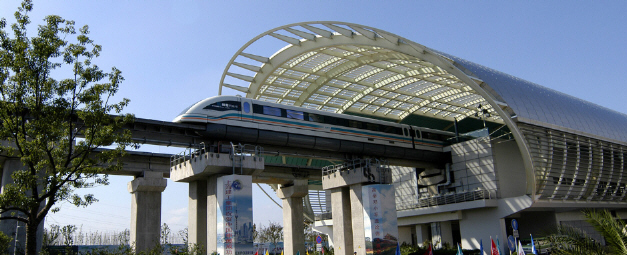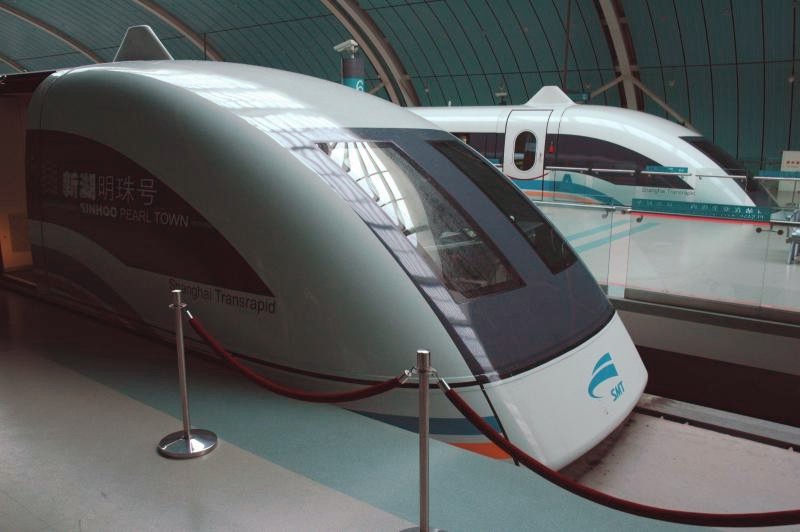Concept
A high speed Maglev Monorail between Melbourne Airport and Melbourne CBD as part of the Melbourne-Sydney maglev.
Travel time is likely to be 7 or 8 minutes with service intervals of about 5 minutes.
Currently Melbourne has no rail link to the airport.
While Maglev trains may operate at up to 500 km/h it is envisioned that this link would operate with a top speed of about 240 km/h so that train noise does not exceed noise from normal road traffic.
(An alternative ALWEG monorail link to Melbourne Airport is proposed here. This alternative forms part of our Melbourne Skyrail proposal.)
Route
East Albion Route
This largely follows the Government's preferred route to the airport for a conventional rail link but follows the Western Ring Road from Albion instead of the freight line.
Points could be added near Tottenham that would allow maglev lines to Geelong or Ballarat to share the line from Tottenham to the city, although this could lead to congestion of the line from Tottenham to the Southern Cross.
|
View Melbourne Airport Maglev Link via East Albion in a larger map Approximate path of the Albion East Route to Melbourne Airport. |
City Link Route via Re-Developed Essendon Airport
A more obvious route would be to follow CityLink to the airport. However, this route is problematic as the elevated maglev track would impinge on the flight path or aircraft using either of the runways at Essendon Airport. (See here and here.) This is made worse by the track needing to bank sharply at the end of the East-West runway due to the tight corner.
Redevelopment of Essendon Airport for other purposes would change this calculation by shortening the route and hence the cost of this link and the overall Melbourne-Sydney maglev. A maglev station could be a central feature of any new development of the Essendon Airport site.
Additionally this route would not obstruct a Melbourne-Geelong maglev at Footscray.
Technical proof-of-concept
The 30 km Shanghai Airport Maglev is an ideal technical proof-of- concept system for a Melbourne Airport Maglev. The crucial lesson from Shanghai is that the maglev needs to go right into the CBD instead of terminating in the suburbs.
Trains

Transrapid TR09 interior. This shows 2 x 2 seating. We would use 2 x 3 for most seating given the 3.7 meter wide carriages. Trains would not contain toilets or cafes given the short duration of the journey. |
Initially trains could consist of just two end carriages. As passenger load increases up to eight central carriages can be added to create a train up to 10 carriages long. With a mixture of first and second class seating a ten-carriage train would carry about 900 passengers.
Maglev trains are fully automated. We would place the train operator in a central cabin with full access to all relevant information regarding train and track status.
Pillars
The pillars are to be covered in hardy creepers such as Ficus pumila (below) and hanging plants of various types. The pillars will contain an irrigation system capable of keeping these plants alive in harsh weather.

Landscaping
Extensive landscaping under and around the track is included in the price with the intention of making the whole system an attractive addition to the Melbourne landscape. Thousands of trees would be added with bike paths, BBQ areas and other facilities.
|
|
Stations

A Shanghai maglev station. |
Only two stations are to be provided on this link. These stations should be built to accommodate trains of up to ten carriages which require the platforms to be 260 meters long.
Melbourne Airport Station
The station would be situated above Centre Road and would be linked to the main terminal by Travelators.
The maglev track will extend several hundred meters north of the Airport perimeter to a maintenance and storage facility. This would also allow the track to be extended north towards Seymour, Albury Wodonga and Sydney.
Southern Cross Station
At the Melbourne end of the line new Maglev platforms are to be constructed over Wurundjeri Way adjacent to the existing Southern Cross Station. These new platforms would provide immediate access to the rest of the station, Collins Street, Bourke Street footbridge, Etihad stadium and to the Melbourne CBD. Air bridges could also be built from the Maglev platform concourse to the buildings on the west side of Wurundjeri Way to improve the link to the Docklands area.
See also this Station Map (PDF) for Southern Cross Station.

Shanghai Maglev Trains at Longyang Station (www.focusonmicroscopy.org ) |
Tottenham Station (Optional with East Albion route)
The Government may wish to add a station in the Western Suburbs. If so we propose Tottenham as this has a large amount of undeveloped industrial land which could be used to build a new CBD area serviced by the maglev and multiple other existing rail lines. This is also where the Geelong Maglev would branch from the airport maglev track.
Essendon Station (Optional with CityLink route)
A maglev station could be used as the centre-piece of any Essendon Airport redevelopment. The maglev cannot be routed along CityLink unless Essendon Airport was redeveloped.
Richmond Station (Optional)
The Government may wish to extend the track 3.7 km from Southern Cross station to Richmond Station. This would allow passengers to bypass the congested city area and then transfer to existing rail services on the other side of the city centre.
Station Layout
The proposed stations have three platforms each like those shown above. Passengers enter trains via the central platform boarding whichever train comes first. Departing passengers leave via whichever edge platform their train arrives next to. Exit side doors open first to allow passengers to start clearing the carriages on one side before passengers start boarding from the other side.
Operation
Train running
Three trains would be used to shuttle passengers from the city to the airport. Using three trains means that normally only one train is accelerating and once decelerating at any given time. This means the electricity generated by the breaking train can be used to assist in the launch of the accelerating train. Normally only one train would be at rest at one of the stations.
No timetable would be used due to the short service frequency. Instead trains will run as often as they can to deliver the best service possible at any given time.
With only two stations trains would cruise at about 240 km/h for the central 15 km of the journey.
If the optional Tottenham station was added the trains would operate at a reduced speed and so therefore the journey time would be longer. Between Tottenham and the Airport the train could speed could reach 200km/h.
Baggage
The front and rear section of the trains would be used for baggage trolleys. Passengers and station staff would put large baggage on to the trolleys before boarding. This would speed train loading and avoid excessive baggage in the passenger cabin area.
Cost
East Albion Route
Capital cost would be around $1.4 billion for the dual-track, two stations and three four-carriage trains. The trains could be expanded to ten carriages later and service intervals can be reduced to three minutes.
City-Link Route
This would save about $400 million. Revenue from the re-development of the Easendon Airport site could substantially fund this project.
Use the calculator below to determine the cost per week for each benefitting household.
This script provided by JavaScript Kit
There are about 1,400,000 households in Melbourne. Most would benefit in some way from the Maglev as either a way to get to the airport or from reduced vehicle traffic around the airport.
Funding
Victorian State Funding
Assuming a $1.4 billion price the State of Victoria could fund this airport link by applying a small 'Transport Levy' to the following existing taxes:
- An approximately 3.5% addition to Land transfer duty (on average).
- An approximately 8% addition to Land tax (on average).
- An increase in brown coal royalties.
- Some combination of the above.
These would raise enough money to cover the annual cost of the debt and allow repayment in 20 years. It is proposed that the land tax levy rate would vary by region with no levy being charged in regions that do not benefit from the link and a higher levy being charged on regions that would benefit.
Note the very pessimistic assumption here that ticket sales only cover operating costs.
(These estimates are based on 2012-13 Tax Revenue data which is from Chapter 4 of Victorian State Budget (See 'Budget Papers 5: Statement of Finances'. )
Federal Funding
The Federal Australian Government currently directs transport funding to Victoria far in excess of the amount required for this project. They could choose to fund this airport link instead of other proposed projects such as the 9km $9 billion Melbourne Metro or the East-West road tunnel.
Ticket Price
Maglev's have low operating costs and minimal wear and tear on the vehicles or guide way so ticket price should be similar to current Metro tickets. Note also that this maglev will operate at the low speed (for a maglev) of about 240 km/h which will reduce energy consumption.
A substantial discount to airlines would be offered if they bundled the maglev ticket with all their airline tickets. Travellers holding tickets for these airlines would get priority entry to the maglev via separate gates.
Speed
The Transrapid web site gives data four points of data for curve radii here. Plotting this as a graph enables estimation of minimum curve radii for any given speed.
Using the above data we estimate the top speed around the corners would be about 280 km/h which is quite fast enough for this link.
Park and ride
Currently Melbourne Airport derives a substantial part of its profit from car parking. This could continue if a city maglev link was built as residents of nearby suburbs and the north-west drive to the airport and catch the train to Melbourne.
Public Opinion
Improving public transport to the airport has strong support in Melbourne. This Age
Article and Age Poll is a good example.
Future Links
This Maglev link would provide the foundation for a much wider Maglev Fast Rail network.
- Geelong & Avalon Airport Maglev. A 12 minute service to Geelong.
- Melbourne-Sydney Maglev. A 2 hour service to Sydney CBD from Melbourne CBD.
- Ballarat or Bendigo Maglevs. A 20 minute service to either city..
- East Gippsland Maglev. A 40 minute service to Bairnsdale..
